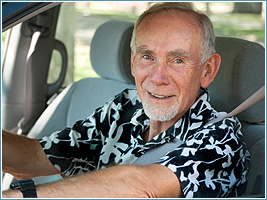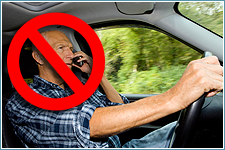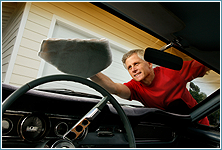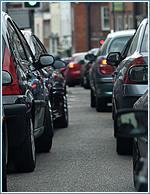Your Driving :: Driving Tips

The safest time to drive is during the daylight and in good weather. It is encouraged that you find the safest route with well-lit streets, intersections with left turn arrows, and easy parking. You should also plan your route before you drive and share your plan with others. The following are some tips for being a safer driver, both on and off the road.
- On the Road
- Move into an intersection only when you have checked the area for pedestrians, cyclists, vehicles, and any other hazards
- Don't allow other drivers to pressure you into sudden moves
- Leave a large following distance behind the car in front of you
- Drive at the posted speed limit. If you must drive more slowly, stay in the right lane
- Always signal before turning. Cancel your turn signal if it does not shut off automatically after a turn
- Keep eyes moving to scan the roadway from shoulder to shoulder to avoid highway hypnosis
- Drive with low beams during the day, especially on two-lane roads
- In the Car
- Limit conversation while driving
- Keep the radio volume low
- Do not talk on your cell phone or text

- Avoid eating while driving
- Discourage smoking. Smoke in the vehicle aggravates breathing problems and leaves a film on your windshield that may interfere with your visibility
- Put on your headlights and seat belt, even for quick trips
- If your car does not have an automatic reminder to fasten seat belts, leave yourself a note on the dashboard or sun visor
- If your seat belt is extremely uncomfortable or cannot be fastened properly, take it to a competent mechanic for alterations. Many cars have adjustable shoulder belt mounts or you can buy devices that improve the fit
- Adjust your mirrors and seats for a comfortable fit. For more information, please reference the Your Vehicle pages
- Out of the Car
 Clean your headlights, taillights, windshield and rear window inside and outside
Clean your headlights, taillights, windshield and rear window inside and outside- Clean your wiper blades with a paper towel dipped in windshield washer fluid to remove grime and oxidized rubber from the edge of the blade (helps prevent streaking)
- Check your tire pressure at least once a month, and always before a long trip
- Ask that your oil, transmission and coolant levels, as well as fluids and all engine belts, be checks when you have your oil changed
- Exercise regularly to increase strength and flexibility
- Consider a defensive driving or driver improvement course
- Map out a safe route to grocery stores, malls, doctors' office, and other common destinations, and practice driving it with a friend or family member (See "Trip Planning" below)
- Plan a route that only uses right turns if left-handed turns are too difficult to maneuver
- Think about potential alternatives to driving, such as riding with a friend or using public transit
- Be honest with yourself. If you are a danger on the road, take responsibility and either improve your skills or stop driving
- On longer trips
- Take a break after every 90 minutes of driving
- Have a beverage or a snack, walk around, and move your arms
- Keeps you alert, improves circulation, and helps prevent stiffness and fatigue

- Stretch before and after long drives. More information
- Note landmarks and exits that will help you navigate and remember your route
- At the Doctor
- Schedule regular check-ups and eye exams
- If you wear glasses, update your prescription regularly
- Keep glasses clean and in good shape
- Consider contact lenses for optimal peripheral vision
- Choose lightly tinted polarizing sunglasses or prescription sunglasses for daytime driving
- Ask your doctor or pharmacist to review medicines-both prescription and over-the counter-to assess side effects and drug interactions that may affect your driving
- At Night
- Use high beams when no one is in front of you on the road
- As vehicles approach, look toward the right side of the road
- Drive with your dash lights dimmed. Keep light-colored or reflective objects off the top of the dash
- Adjust rear-view mirror to the night setting to cope with glare
- Keep a flashlight on hand to read signs and house numbers at night
- Also consider planning a rehearsal run of your trip in the daylight
- When to Avoid Driving
 When you are tired, depressed, or angry
When you are tired, depressed, or angry- If you frequently become angry in heavy traffic, try to avoid the kind of traffic that would generate such feelings
- At dawn and dusk when fog may be present
- If you must drive somewhere after dark, please see tips for driving at night (above)
- More than one hour past bedtime
- When taking medication that could cause drowsiness, impair your driving, or have other adverse side effects
- When you have been drinking
- When severe weather conditions are predicted
- Trip Planning
- Maturity and foresight can help you minimize your driving risk by making simple adjustments to your driving habits. Follow these simple tips to ensure a safe, well-planned trip:
- Let your family and friends know where you are headed
- Check your car to assure it has a spare tire, jumper cables, water, a flashlight, and an alerting device such as reflective triangles, flares, or light sticks
- Plan the time of day you will be driving, avoiding night driving and rush hour traffic
- Plan the stops you will make along the way
- Check the road, weather and traffic conditions before you leave
- Check your side and rearview mirrors
- Adjust your head restraint. Sitting in your seat, reach behind you with both arms. Firmly grasp the headrest and pull up. The center of the headrest should coincide directly with the back of your head
- Estimate your toll expense online and ensure you have money on hand
- Consider planning a trip through DART instead!
- Have a safe trip!
- Maturity and foresight can help you minimize your driving risk by making simple adjustments to your driving habits. Follow these simple tips to ensure a safe, well-planned trip:
- Tips for Navigating Roundabouts
 A roadway "Roundabout" is a circular intersection that moves traffic counterclockwise around a central island without the aid of traffic signals. They help decrease vehicle emissions and fuel use, manage traffic congestion, reduce vehicle speeds, and improve safety.
A roadway "Roundabout" is a circular intersection that moves traffic counterclockwise around a central island without the aid of traffic signals. They help decrease vehicle emissions and fuel use, manage traffic congestion, reduce vehicle speeds, and improve safety.
- Slow down and prepare to yield as you approach the roundabout
- On the approach, you must be in the right lane (if it has more than one lane)
- You must yield to the traffic already in the roundabout and coming from your left
- Stay to the right as you approach your turn
- Place your right turn signal on until you have exited the roundabout
- Delaware's "Move Over" Law
In Delaware alone, dozens of state and local police officers have been injured or killed by passing motorists while they were working outside of their vehicles conducting traffic stops. That is why Delaware enacted a Move Over Law in 2007 to protect emergency workers on our roadways. These emergency workers include law enforcement officers, EMS personnel, ambulances, firefighters, fire police, park rangers and Dept. of Transportation personnel. The law says that any driver approaching an authorized emergency vehicle that has its lights flashing and is stopped on a roadway having two or more lanes in the same direction will either:- Safely "move over" into a lane that is not next to the emergency vehicle, or
- Reduce the vehicle's speed to a "safe speed" while passing the emergency vehicle if changing lanes would be impossible or unsafe
Violators of this law may be fined $25.00 plus court costs.
Ultimately, this law will also serve to protect drivers who are stopped for traffic violations, have broken down on the road, or have been injured in a crash. Breakdowns can be dangerous for everyone involved if other drivers are not paying attention. So remember, it could be you on the side of the roadway.
- Delaware Bans Cell Phone and Hand-Held Electronic Device Use While Driving
On January 2, 2011, Delaware will ban texting while driving and ban the use of hand-held cell phones. This means a hands-free device will be required to talk on a cell phone while driving.
Drivers are permitted to dial a phone number or activate/deactivate their wireless equipment, and then they must put the device down.
The law also bans the use of pagers, PDAs, BlackBerry devices, laptops, games or portable computers, and two-way communication devices while driving.
Drivers cannot browse wirelessly or read, write or send messages while driving.
It is a primary offense and a civil penalty. No points are assessed.
The fine for the first offense is $50.00 and subsequent penalties are between $100 and $200 dollars.
Exemptions:
- Law enforcement, firefighter, EMS technician, or other operators of authorized emergency vehicles in the performance of their official duties
- Anyone reporting an emergency
- Exempts a person driving or operating a farm tractor, non-registered farm truck or farm equipment
- HAM radio operators
- Business or government employees who use a two-way radio mounted or attached to a motor vehicle to communicate with a central dispatch, base of operation or with other employees (ie: utility companies and DelDOT)
National research shows that drivers using cell phones are four times more likely to get into crashes serious enough to cause injury.
- Be On The Lookout For The New HAWK Traffic Signal!
HAWK stands for High-Intensity Activated Crosswalk. One problem for engineers has been the safety of pedestrians who cross the road at "uncontrolled" locations, those with-out traffic signals or stop signs in-stalled. Some research has even shown that just installing striped crosswalks on high-volume, high-speed roadways may even decrease safety for pedestrians who cross. The HAWK signal is the latest tool that will be utilized in Delaware to combat this problem.









